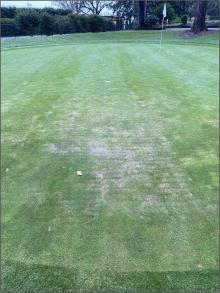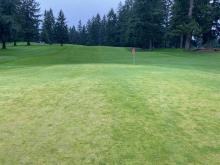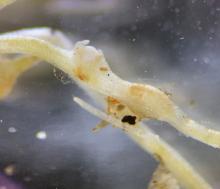See:
Wheat (Triticum aestivum) - Nematode, Root-knot
Cause One or more of at least 14 different types of nematode that cause disease by penetrating roots or sucking sap from the root surface with a mouth part like a hypodermic needle. In addition to the damage they cause by feeding, they leave wounds through which parasitic fungi can enter. Most of these nematodes tend to be migratory ectoparasites, but endoparasites are present as well.
A survey of golf course greens in Oregon and Washington found primarily the root-knot nematodes Meloidogyne naasi in both states and Meloidogyne minor on two courses in Washington.
Symptoms Infested turf lacks vigor and may be discolored, stunted, or thin and may wilt and die in irregular patches. Generally, it resembles turf stressed from fertilizer burn, hard soil, lack of water, or nutrient deficiency.
Sampling Send soil, roots, and whole plants for diagnosis. Take the sample in an area 6 to 10 inches deep with living plants.
Cultural control
- Maintain turf in good condition by adequate watering, fertilizing, etc.
- Turf known to contain parasitic nematodes should be aerified last to help reduce their spread via equipment to other areas.
Chemical control
- Indemnify at 0.195 to 0.39 fl oz/1,000 sq ft. Group 7 fungicide. 12-hr reentry.
- Quali-Pro Nimitz Pro G at 60 to 120 lb/A immediately watered in with a least 0.25 in water. Aerifications 1 to 10 days prior to application improves control. Reentry allowed after watering.
Chemical control for Turf farms only.
- Dominus at 10 to 40 gal/A. Apply as a shank injection to an entire field or raised beds when soil temperatures are above 60°F but not greater than 90°F. 5-day reentry.
- Telone II at 9 to 18 gal/A preplant broadcast or 5 to 10 gal/A on established turf. Do not treat extremely heavy soils. 5-day reentry. Restricted-use pesticide.
Biological control
- DiTera DF (Myrothecium verrucaria strain AARC-0255 fermentation solids and solubles) is registered for many nematodes. Unknown efficacy in the PNW. 4-hr reentry. O
- MeloCon WG (Paecilomyces lilacinus strain 251) at 6.5 oz/1,000 sq ft plus a soil wetting agent can be applied to established plants. Irrigate after application. Stable for only days at room temperature, weeks in the refrigerator, or for a year if frozen. Unknown efficacy in the PNW. 4-hr reentry. O
- Entomopathogenic nematodes used for insect control have also reduced populations of plant parasitic nematodes under turf grass in Georgia and South Carolina.
References Grewal, P.S., Martin, W.R., Miller, R.W. and Lewis, E.E. 1997. Suppression of plant-parasitic nematode populations in turfgrass by applications of entomopathogenic nematodes. Biocontrol Science and Technology 7:393-399.
Groover, W., Held, D., Lawrence, K., and Carson, K. 2020. Plant growth-promoting rhizobacteria: a novel management strategy for Meloidogyne incognita on turfgrass. Pest Management Science, 76: 3127-3138. https://doi.org/10.1002/ps.5867
McClure, M.A., Nischwitz, C., Skantar, A.M., Schmitt, M.E., and Subbotin, S.A. 2012. Root-knot nematodes in golf course greens of the western United States. Plant Disease 96:635-647.





